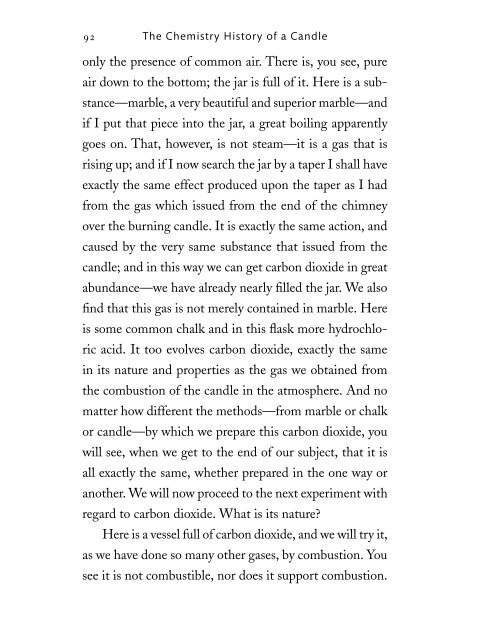Michael Faraday's The Chemical History of a Candle
Michael Faraday's The Chemical History of a Candle With Guides to Lectures, Teaching Guides & Student Activities by Bill Hammack & Dos DeCoste
Michael Faraday's The Chemical History of a Candle With Guides to Lectures, Teaching Guides & Student Activities by Bill Hammack & Dos DeCoste
You also want an ePaper? Increase the reach of your titles
YUMPU automatically turns print PDFs into web optimized ePapers that Google loves.
92 <strong>The</strong> Chemistry <strong>History</strong> <strong>of</strong> a <strong>Candle</strong><br />
only the presence <strong>of</strong> common air. <strong>The</strong>re is, you see, pure<br />
air down to the bottom; the jar is full <strong>of</strong> it. Here is a substance—marble,<br />
a very beautiful and superior marble—and<br />
if I put that piece into the jar, a great boiling apparently<br />
goes on. That, however, is not steam—it is a gas that is<br />
rising up; and if I now search the jar by a taper I shall have<br />
exactly the same effect produced upon the taper as I had<br />
from the gas which issued from the end <strong>of</strong> the chimney<br />
over the burning candle. It is exactly the same action, and<br />
caused by the very same substance that issued from the<br />
candle; and in this way we can get carbon dioxide in great<br />
abundance—we have already nearly filled the jar. We also<br />
find that this gas is not merely contained in marble. Here<br />
is some common chalk and in this flask more hydrochloric<br />
acid. It too evolves carbon dioxide, exactly the same<br />
in its nature and properties as the gas we obtained from<br />
the combustion <strong>of</strong> the candle in the atmosphere. And no<br />
matter how different the methods—from marble or chalk<br />
or candle—by which we prepare this carbon dioxide, you<br />
will see, when we get to the end <strong>of</strong> our subject, that it is<br />
all exactly the same, whether prepared in the one way or<br />
another. We will now proceed to the next experiment with<br />
regard to carbon dioxide. What is its nature?<br />
Here is a vessel full <strong>of</strong> carbon dioxide, and we will try it,<br />
as we have done so many other gases, by combustion. You<br />
see it is not combustible, nor does it support combustion.


